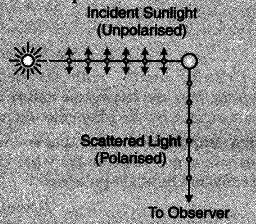(a) Distiguish between linearly polarised and unpolarised light.
(b) Show that the light waves are transverse in nature.
© Why does light from a clear blue portion of the sky show a rise and fall of intensity when viewed through a polaroid which is rotated ? Explain by-drawing the necessary diagram
(a) A light wave, in which the electric vector oscillates in all possible directions in a plane perpendicular to the direction of propagation, is known as unpolarised light.
If the oscillations of the electric vectors are restricted to put one direction, in a plane perpendicular to the direction of propagation, the corresponding light is known as linearly polarised light

[As the electric field vector components parallel to the pass-axis of P1 are transmitted, whereas the others are blocked. ]
When this polarised light is incident on the Polaroid P2 kept crossed with respect to P1 then these components also get blocked and no light is transmitted beyond P2.
© It is due to the scattering of light bv the molecules of earth’s atmosphere.

Under the influence of the electric field of the incident (unpolarised) wave,‘the electrons in the molecules acquire components of motion in both these directions. The charges, accelerating parallel to the double arrows, do not radiate energy towards the observer since their acceleration has no transverse component.
The radiation scattered by the molecule is therefore’ represented by dots, i.e. it is polarised perpendicular to plane of figure.